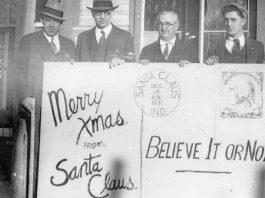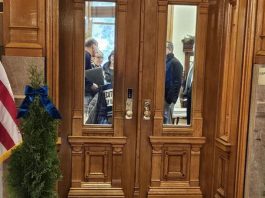Out of Office: The Hidden History Of Central State Hospital
By Victoria Ratliff and Haley Carney
TheStatehouseFile.com
(Editor’s note: Out of Office is the first in an occasional series  highlighting interesting places and activities in Indiana)
INDIANAPOLIS—In the shadows of old wooden bookcases sit jars filled with embalming fluid preserving decades-old brains that have signs of disease caused by tumors, strokes and ulcers.
Sarah Halter sees something more than specimens documenting a history of medicine and disease at the Indiana Medical History Museum. For every jar, she sees the human being who suffered and died.
“For decades, the history that we focused on here was the history of the hospital itself,†said Halter, the museum executive director. “These are all important sides of the story, but what was missing was the patient perspective.â€
Halter has been part of the museum since 2007 when she began an internship there. As an anthropology major at Indiana University-Purdue University Indianapolis and working toward a graduate degree in museum studies, she knew that the museum was the perfect fit.
“When my internship ended, I just never left,†she said.
Two months after graduation, she was offered a full-time position. Since then, she has not looked back. Her love for the places shines through as she takes visitors on the one-tours she provides.
Lining the shelves of the museum are organs preserved from the days more than 60 years ago when patients attended the hospital. Dim overhead lights made it difficult to see exactly what the jars hold.
Halter said the room is a draw for visitors who study the labels explaining the condition of the patients. Her work now is trying to identify each organ and understand the person and their story.
“The patients are the reason the hospital was here,†she said. “They were the reason that the doctors and administrators were working so hard to improve conditions at the hospital.â€
The majority of the organs showed signs of tumors, some being as large as a small apple.
The museum with its macabre history is an eight-mile drive from downtown Indianapolis where, at the end of an uneven road near a makeshift parking lot, the displays are set up in a two-story red brick building.
The 100-acre area site used to be a part of the Central Indiana Hospital for the Insane, later known simply as Central State Hospital.
Now, the Indiana Medical History Museum occupies two of the original buildings on the hospital grounds. The pathology department building, where scientific research on the causes of diseases occurred, and the dead room, where an old doctor’s office is recreated, are the only ones open to visitors. The rest of the buildings have either been torn down or sold for other uses.
The pathology department building is the main portion of the museum. With 15 rooms open to the public, it houses original artifacts from when the property was still a functioning hospital.
The dead room is a small brick building that used to be the morgue, hence its nickname. All of the rooms are preserved so they look as they did when the hospital was operational, including all of the furniture, chemicals, and even specimens found under microscopes and in jars lining the rooms.
In the histology lab, microscopes are set up with slides as they might have been decades ago. The autopsy room still has one metal table where doctors worked on the deceased as well as the refrigerator where remains were stored before embalmment. The library displays original scientific findings from the doctors who worked there.
The staff is small, with one other full-time employee and four part-timers rounding out the team. But, the pool of volunteers is sizable, with 30 people lending their time to help the museum.
The Central Indiana Hospital for the Insane was erected in 1848 with a goal of treating people with mental illnesses at a state hospital. The founders of the hospital wanted to make sure that theirs was different than the typical asylum.
During the 1800s, asylums had reputations as places where the mentally ill were subjected to physical and psychological abuse. After a few years, the facility changed it name to Central State Hospital to reflect the ideal that the mentally ill patients would be treated in a hospital setting, recover and soon return to their families.
“When the hospital was opening, they bragged that eight or nine patients in 10 would recover and go home,†Halter said.
Central State Hospital began to grow rapidly, at one time housing more than 2,000 patients. Officials adapted and built the pathology building, a medical hospital, dormitories for patients, mess halls, laundromats, and even recreational areas.
The laboratories closed in 1968 because they simply couldn’t keep the facilities modern enough. A year later, the pathology department opened as the new Indiana Medical History Museum.
The hospital still housed mentally ill patients, without research laboratories, until it finally closed in 1994.
While the pathology building and dead room are the only remaining buildings owned by the museum, Halter is working on preserving what they do have. The museum is undergoing several changes in order to preserve the building.
“This place is such a unique site and I see so much potential here,†she said. “We’re doing a lot of preservation work with the building.â€
Halter wants the building to be as authentic as possible while keeping the building functional for visitors to continue touring.
Along with the initiative to update outdated parts of the building, Halter has also involved the museum in a project with the Indianapolis Public Library called the Shared Program.
The Indianapolis library is working with numerous groups including 30 elementary schools, threemiddle schools, 12 high schools, and two art museums to catalog information found in books and upload them on the internet.
The library in the pathology building houses more than 6,000 volumes of scientific work that are being catalogued for public access.
For Halter, the museum is a time capsule.
“It’s like stepping back in time. You’ll never find anything else like it in the country.â€
FOOTNOTE: Victoria Ratliff and Haley Carney are reporters for TheStatehouseFile.com, a news website powered by Franklin College journalism students.




More pictures here: http://thestatehousefile.com/office-hidden-history-central-state-hospital/39124/
Comments are closed.